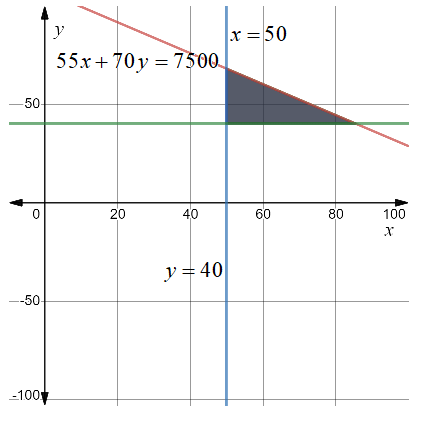
(a)
To graph: A system of inequalities for different amount of food X and food Ywith the help of prescribed plan by dietician.
(a)
Explanation of Solution
Given:
The maximum weight to hold the weight in the truck is 7500 pounds. A warehouse requires at least 50 packages to ship of 55 pounds and at least 40 bags of stone to ship of 70 pounds.
Graph:
Consider x as the amount of 55lb bags and y as the amount of 70lb bags.
The maximum weight to hold the weight in the truck is 7500 pounds. A warehouse requires at least 50 packages to ship of 55 pounds and at least 40 bags of stone to ship of 70 pounds.
As per the given information, the inequalities are set up as follows:
Draw the graph with the help of lines
Find the coordinates of the line
Substitute
Further simplify the above calculation.
Substitute
The coordinates are
Shade the region above the lines for the sign of at least and shade the region below the line for the sign of at most in three inequalities.
Now draw the graph with the help of obtained coordinates of the lines.

Figure 1
Interpretation:
It can be observed from the graph that the shaded region lies in the first quadrant.
(b)
To find: Two solutions from and interpret the result.
(b)
Explanation of Solution
Solutions of the system of inequalities are those points that comes under the feasible region of the graph.
The feasible region of the graph is the shaded region of the graph.
Take any two points from the shaded region of the graph.
It can be seen from the graph that the points
The point
The point
Chapter 7 Solutions
EBK PRECALCULUS W/LIMITS
- 5:38 Video Message instructor Submit Question ||| Darrow_forward8:38 *** TEMU TEMU -3 -2 7 B 2 1 & 5G. 61% 1 2 -1 Based on the graph above, determine the amplitude, period, midline, and equation of the function. Use f(x) as the output. Amplitude: 2 Period: 2 Midline: 2 ☑ syntax error: this is not an equation. Function: f(x) = −2 cos(πx + 2.5π) +2× Question Help: Worked Example 1 ☑ Message instructor Submit Question ||| <arrow_forward8:39 *** TEMU 5G 60% A ferris wheel is 28 meters in diameter and boarded from a platform that is 2 meters above the ground. The six o'clock position on the ferris wheel is level with the loading platform. The wheel completes 1 full revolution in 4 minutes. The function h = f(t) gives your height in meters above the ground t minutes after the wheel begins to turn. What is the amplitude? 14 meters What is the equation of the Midline? y = 16 What is the period? 4 meters minutes The equation that models the height of the ferris wheel after t minutes is: f(t): = ƒ (3) = ·−14(0) + 16 syntax error: you gave an equation, not an expression. syntax error. Check your variables - you might be using an incorrect one. How high are you off of the ground after 3 minutes? Round your answe the nearest meter. ||| <arrow_forward
- Use Laplace transform to find L{f(t)} f(t) = tsin(t)arrow_forward√3/2 1 √1-x2 arcsinx 1/2 dx = 2arrow_forwardThe evolution of a population of Hippos, R(t), in hundreds, time in years, in an African National Park is given by the equation, dR dt (a) Solve the system exactly for R(t). = R(7 – R); R(0) = 3 2 (b) What happens as the time t → ∞o, i.e. what is the population a long time in the future? (c) Write an Euler scheme and compute until the population levels off (using Excel, Matlab, Octave, LibreCalc or similar). Do it twice, once with At = 0.1 and once with At = 0.05. (d) Plot all of your solutions on the same set of axes and comment.arrow_forward
- find For triangle ABC, with vertices A = (3,-1,2), B = (-5,4,-4) and C = (6, −1, −1), (a) the length of side AB, (b) the equation of the line that passes through A and B, (c) the angle at vertex B, (d) a vector perpendicular to the plane containing the triangle ABC, (e) the area of the triangle ABC. (f) the equation of a plane passing through A, B and C.arrow_forwardShowing all working, use the row reduction method to find the inverse of B, given by 5 -1 B = -3 1 3 1 -3 2arrow_forwardConsider the matrix A, given by +63) A = 1 -3 4 -3 4 5 -105 (a) Find the determinant of the matrix, A. (b) Find all possible solutions, x, to the system Ax = b, where b is the column vector, (1,2, −4).arrow_forward
 Calculus: Early TranscendentalsCalculusISBN:9781285741550Author:James StewartPublisher:Cengage Learning
Calculus: Early TranscendentalsCalculusISBN:9781285741550Author:James StewartPublisher:Cengage Learning Thomas' Calculus (14th Edition)CalculusISBN:9780134438986Author:Joel R. Hass, Christopher E. Heil, Maurice D. WeirPublisher:PEARSON
Thomas' Calculus (14th Edition)CalculusISBN:9780134438986Author:Joel R. Hass, Christopher E. Heil, Maurice D. WeirPublisher:PEARSON Calculus: Early Transcendentals (3rd Edition)CalculusISBN:9780134763644Author:William L. Briggs, Lyle Cochran, Bernard Gillett, Eric SchulzPublisher:PEARSON
Calculus: Early Transcendentals (3rd Edition)CalculusISBN:9780134763644Author:William L. Briggs, Lyle Cochran, Bernard Gillett, Eric SchulzPublisher:PEARSON Calculus: Early TranscendentalsCalculusISBN:9781319050740Author:Jon Rogawski, Colin Adams, Robert FranzosaPublisher:W. H. Freeman
Calculus: Early TranscendentalsCalculusISBN:9781319050740Author:Jon Rogawski, Colin Adams, Robert FranzosaPublisher:W. H. Freeman
 Calculus: Early Transcendental FunctionsCalculusISBN:9781337552516Author:Ron Larson, Bruce H. EdwardsPublisher:Cengage Learning
Calculus: Early Transcendental FunctionsCalculusISBN:9781337552516Author:Ron Larson, Bruce H. EdwardsPublisher:Cengage Learning





